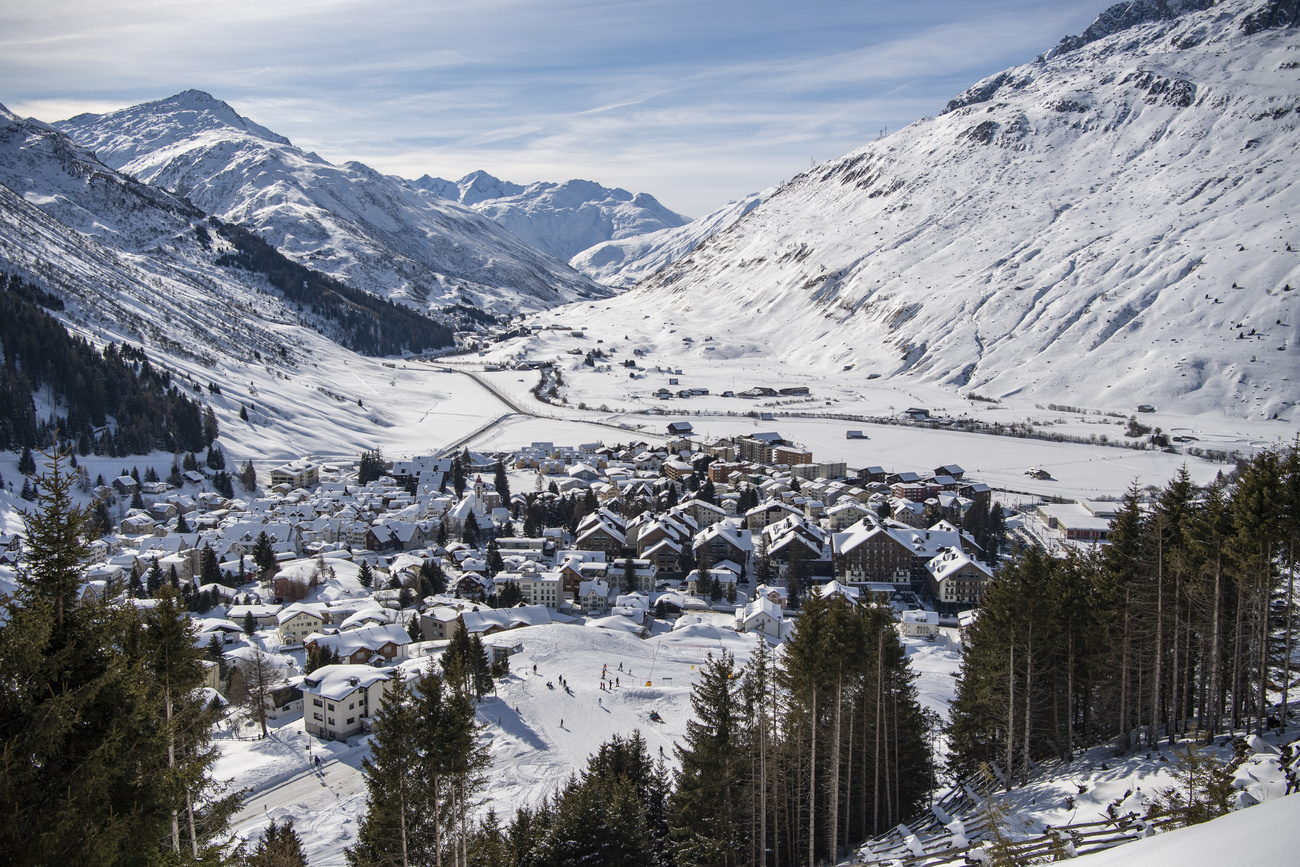An eye-opening guide to Switzerland’s ear-splitting sirens

Every year, on the first Wednesday in February, the sound of 7,200 sirens dotted around Switzerland fills the air, startling anyone who doesn’t realise it’s a test. But would you know what to do if it was for real?
The first time I heard the sirens being tested, I was confused and mildly concerned. I coolly looked around the office, and it was only when I saw a colleague looking at his watch and nodding that I slowly worked out what was happening.
Embarrassingly, I’d missed the reminders in the media that every siren in Switzerland would be going off at 1.30pm. Twenty years later, I still find the first few seconds rather disconcerting.
“The general public is not required to respond in a particular way or take protective measures but is simply requested in advance to excuse the inconvenience caused by the noise of the sirens,” the Federal Office for Civil ProtectionExternal link (FOCP) says in a charmingly courteous Swiss manner.
Here’s a popular advert made by the FOCP to raise awareness of the siren test (with a nod to the classic video artwork Der Lauf der DingeExternal link/The Way Things Go by Swiss artists Peter Fischli and David Weiss).
Almost every country in the world uses localised sirens to warn its citizens of some impending danger, whether it’s invasion, rocket attacks, nuclear accidents or natural disasters (tsunamis, volcanoes, tornadoes, earthquakes). Switzerland’s 5,000 stationary and 2,200 mobile sirens make up one of the broadest national networks of civil defence sirens in the world.
People have been warning their neighbours of danger ever since they could shout, bang a drum, blow a horn or ring a bell. French physicist Charles Cagniard de la Tour (1777-1859) is considered the inventor of the modern siren, in 1819. But how did thousands of them end up spread across Switzerland?
“From the First World War onwards, sirens were occasionally used in Switzerland for fire alarms,” curator and historian Juri Jaquemet explained in a blog post for the Swiss National MuseumExternal link.
In April 1920 the fire department in Thun conducted an initial trial, but the siren, installed on one of the turrets of the castle, gave an “underwhelming performance”. “The alarm of this motorised siren is not powerful enough to rouse the people from their sleep, nor is it able to penetrate effectively and adequately through daytime noise,” reported the Oberländer Tagblatt.
The Second World War, and the accompanying aerial threat, resulted in the Swiss government ordering local authorities “to provide air raid warnings, to install fixed and mobile sirens”. During the war, Bernese company Gfeller AG started offering the first technical solutions for controlling and activating multiple sirens simultaneously via a telephone line.
While the Cold War led to a boom in bunker construction, less attention was paid to actual alerts – with the exception of the water alarm. Following the Vajont Dam disasterExternal link in Italy in 1963 in which some 2,000 people died, the authorities were terrified something similar could happen in Switzerland. From 1971, areas that were within a two-hour radius of a potential dam tsunami had to have a siren system in place.
In the 1970s concerns about nuclear disasters saw new alarm systems put in place. That’s all well and good, but as the Freiburger Nachrichten reported in 1987, residents in some municipalities with sirens hadn’t been told what to do if the alarm was sounded.
From the 1980s, civil defence authorities worked to create a denser alarm network and standardised test alarms across Switzerland. Sirens were heard simultaneously across the country for the first time at 1.30pm on Wednesday September 1, 1982. “The outcome of the drill was quite underwhelming,” Jaquemet noted. “In the cantons of Jura, Valais, Vaud, Obwalden and Graubünden, the alarm systems were not set up ready for operation, and the wailing mechanisms remained silent.”
In 1988 the federal government made the siren test mandatory. From 1981-1990 a siren test was carried out twice a year, on the first Wednesdays of February and September. After that, a parliamentary initiative – based on the good condition of the sirens – reduced this to a single alarm.
(Source: Sirens, compressed air and spine-chilling howlsExternal link, Swiss National Museum)
“Switzerland – or parts of the country – can be hit by natural, technological or societal disasters and emergencies at any time,” the FOCP warns. “If there is an imminent danger to the population of Switzerland, a siren is sounded.”
In Switzerland there are two sirens: the general alert, for a possible threat to the population, and the water alert, for people who live below “water-retaining structures” (dams). Since 2018, alerts have also been sent to smartphones via the Alertswiss websiteExternal link, which also carries emergency information.
The Alertswiss appExternal link provides information about natural disasters such as floods or forest fires and alerts users to dangers such as chemical or nuclear power station accidents and potential terrorist attacks. The Alertswiss app is available free for iOSExternal link and AndroidExternal link.
At 1.30pm on the first Wednesday in February the general alert is tested throughout the country. This is a regular ascending and descending tone, which lasts for one minute and is repeated once after a two-minute interval. Where necessary, the sirens can continue to be tested until 2pm.
“Allgemeiner Alarm MP3”. Released: 2002.
From 2pm to 4.30pm (at the latest), the water alert is tested in those areas that are close to dams. It consists of 12 low continuous tones lasting 20 seconds and repeated at ten-second intervals.
“Wasser MP3”. Released: 2002.
Most years, 99% of sirens work – within the normal margin for error, according to the FOCP.
The Swiss network is unique because it covers both urban and rural regions. “For instance, we not only have fixed sirens but mobile sirens which are installed on top of cars and, in case of an alert, are driven along a specific route in a remote region to ensure that people are informed,” Dennis Rhiel, head of information at the FOCP, told SWI swissinfo.ch.
“Our neighbouring countries still have quite a lot of sirens installed but no other country has such a broad system as Switzerland,” he said.

The real deal
So what happens if the sirens go off and it isn’t 1.30pm on the first Wednesday in February?
If it’s the general alarm, “consult the Alertswiss app or website for information and listen to the radio”, says ch.ch, the government’s information portalExternal link. “Swiss public television and many private radio stations broadcast the instructions of the authorities on what to do in a disaster or emergency. Follow their instructions.”
If it’s the water alarm, “leave the danger area immediately. Follow the instructions of the authorities, local information sheets, and consult the Alertswiss app”.
Real-life cases where the general alarm has been used include in Bern in 2007 when the River Aare rose to dangerously high levels. The alarm was activated, warning people to protect their belongings and keep away from the river. In 2008, the sirens went off in the small town of Adliswil near Zurich. Residents who turned on their radios learnt that their water had been polluted and should be boiled before drinking.
The FOCP acknowledges that some people, for example those who are deaf, can’t be warned directly. There are also people who, although they hear the sirens, can’t pick up the necessary information because they don’t speak the language. “Therefore, it’s important for neighbours to inform each other,” it says. (The authorities also recommend keeping a transistor radio and a spare set of batteries at home.)
Here is this year’s siren reminder:
Out of date?
As technology develops, are sirens out of date? Not for the time being. In November, the government said it wanted to modernise the disaster warning system with alerts sent via the mobile phone network and other digital channels. Cell broadcast technology, for example, allows messages of around 500 characters to be sent to all cell phones within an antenna’s reception range. But the traditional system of warning sirens would remain in place, it said.
The government is also considering scrapping the requirement for Swiss homes to maintain underground bunkers with fewer than seven spaces. As part of the country’s civil protection strategy, Switzerland has had a unique “shelters for all” policy since 1963: every resident must have a spot in a bunker in case of a catastrophe. But that’s another story…
Edited by Samuel Jaberg/dos
More

In compliance with the JTI standards
More: SWI swissinfo.ch certified by the Journalism Trust Initiative











You can find an overview of ongoing debates with our journalists here . Please join us!
If you want to start a conversation about a topic raised in this article or want to report factual errors, email us at english@swissinfo.ch.